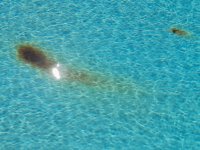We're close to getting a contractor to resurface and tile our pool. I've decided on Universal White Cement plaster and I almost have the contract down to what we need. We have what I think are rust issues coming up in our pool which I'll try to attach. The biggest stain is about 5" in diameter and spreading. A second one has popped up as I'm getting bids. It looks like it's coming from what one bidder called calcium nodules. One person was convinced it was my water chemistry, so I sent that day's report to him which proved otherwise. We aren't perfect but I'm not sure this is what it could be. From what I've read on the internet, the way this is repaired is to cut out all rusted metal (which I thought was supposed to be 3" below gunite), treat the ends with rust inhibitor, then fill with hydraulic cement. Since workers found rusted rebar in a replaced skimmer about 2 yrs ago, I am replacing tile and doing a full chipout. My questions are 1. Am I following the rust process correctly? 2. Is the gunite bonded on complete chip out? I have one telling me no, which is what I understand to be correct and one telling me bonding after complete chip out is how it's done. 3. In the meantime, I've disconnected the salt generator and I'm using Cl tabs unitl they come to fix it about April 29. I'd appreciate any thoughts.
Remodel Questions
- Thread starter cpp80
- Start date
You are using an out of date browser. It may not display this or other websites correctly.
You should upgrade or use an alternative browser.
You should upgrade or use an alternative browser.
oldprophet
In The Industry
That's rusting rebar bleeding through the plaster Digging up the area and repairing it as described in your post is the only way to repair it. Cutting out a piece of rebar should not be a bonding issue
Thank you. I'm sorry for confusing these two questions. The question about the bonding is concerning the full chipout of old plaster down to the gunite. My understanding is gunite does not need a bonding agent before the plaster is applied unless there is still plaster left. Is this correct? I have one contractor (and several articles) telling me that you don't need the bonding agent on a full chipout. I have another telling me he uses a bonding agent on the gunite after a full chipout before applying plaster.
A full chip out great! Bonding agent cannot hurt but is not really needed due to the full chip out. The roughness of the chipping out should allow the plaster to stick.
Thank you for replying.A full chip out great! Bonding agent cannot hurt but is not really needed due to the full chip out. The roughness of the chipping out should allow the plaster to stick.
So one contractor says hydraulic cement not needed. He says he fills with plaster, not hydraulic cement. Several bidders have said this and I wonder why. I have one saying hydraulic cement. Why ate so many saying plaster fill?That's rusting rebar bleeding through the plaster Digging up the area and repairing it as described in your post is the only way to repair it. Cutting out a piece of rebar should not be a bonding issue
Maybe @AQUA~HOLICS can provide you the best solution as he is a well respected contributor on the forum.So one contractor says hydraulic cement not needed. He says he fills with plaster, not hydraulic cement. Several bidders have said this and I wonder why. I have one saying hydraulic cement. Why ate so many saying plaster fill?
AQUA~HOLICS
In The Industry
The use of a hydraulic cement or plaster is typically based on the size of the void to be repaired. The rust that makes it to the surface travels through the crack in the Shotcrete that exposed the rebar and that may be a distance away from where it meets the surface. I prefer to have all the rusted rebar removed completely then the ends sealed, typically the exposed area will be too big for filling with plaster and hydraulic cement is used.
Thank you everyone for responding. Aqua-Holics, your description gives me a great visual. This information is helping me to choose the contractor who will be doing our remodel. Praying we don't see this reappear down the road...
Thread Status
Hello , This thread has been inactive for over 60 days. New postings here are unlikely to be seen or responded to by other members. For better visibility, consider Starting A New Thread.


